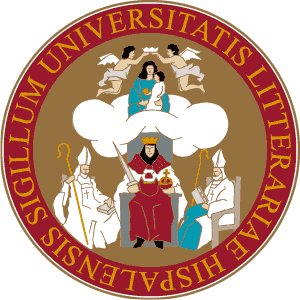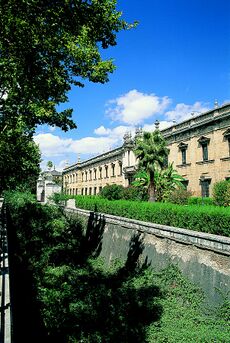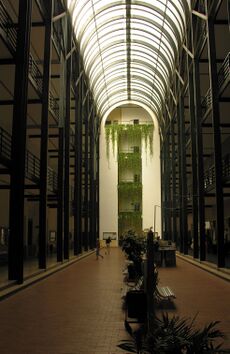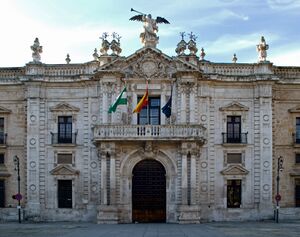جامعة إشبيلية
Universidad de Sevilla | |
 Seal of the University of Seville | |
| النوع | Public |
|---|---|
| تأسست | 1505 |
| الانتساب الأكاديمي | PEGASUS |
| الميزانية | 497.776.950€ |
| الطلبة | 69.200 |
| الموقع | ، ، 37°22′51″N 5°59′28″W / 37.38075790°N 5.99123070°W |
| ألوان المدرسة | Yellow and Red[1] |
| الموقع الإلكتروني | www |
 | |
| ترتيب الجامعات | |
|---|---|
| Global – Overall | |
| ARWU World[2] | 401-500 (2019) |
| CWTS World[3] | 297 (2019) |
| QS World[4] | 601-650 (2020) |
| THE World[5] | 801–1000 (2020) |
| USNWR Global[6] | 522 (2020) |
The University of Seville (Universidad de Sevilla) is a university in Seville, Spain. Founded under the name of Colegio Santa María de Jesús in 1505, it has a present student body of over 69.200,[7] and is one of the top-ranked universities in the country.[بحاجة لمصدر]
التاريخ
The University of Seville originally dates to the 15th century. Created by Archdeacon Maese Rodrigo Fernández de Santaella, it was originally called Colegio de Santa Maria de Jesus, and was confirmed as a practicing university in 1505 by the papal bull of Pope Julius II. Today, the University of Seville is known for research in technology and science.[8]
In the middle of the 13th century, the Dominicans, in order to prepare missionaries for work among the Moors and Jews, organised schools for the teaching of Arabic, Hebrew, and Greek. To cooperate in this work and to enhance the prestige of Seville, Alfonso the Wise in 1254 established "general schools" (escuelas generales) of Arabic and Latin in Seville. Alexander IV recognized this foundation as a generale litterarum studium by the Papal Bull of 21 June 1260 and granted its members certain dispensations in the matter of residence. Later, the cathedral chapter established ecclesiastical studies in the College of San Miguel. Rodrigo Fernández de Santaella, archdeacon of the cathedral and commonly known as Maese Rodrigo, began the construction of a building for a university in 1472; in 1502 the Catholic Monarchs published the royal decree creating the university, and in 1505 Julius II granted the Bull of authorization; in 1509 the college of Maese Rodrigo was finally installed in its own building, under the name of Santa María de Jesús, but its courses were not opened until 1516. The Catholic Monarchs and the pope granted the power to confer degrees in logic, philosophy, theology, and canon and civil law. The colegio mayor de Maese Rodrigo and the university proper, although housed in the same building, never lost their separate identities, as is shown by the fact that, in the 18th century, the university was moved to the College of San Hermenegildo, while that of Maese Rodrigo remained independent, although languishing.[9]
Influence
The influence of the University of Seville, from the ecclesiastical point of view, was considerable, though not equal to that of the Universities of Salamanca and of Alcalá. Renowned alumni include Sebastián Antonio de Cortés, Riquelme, Rioja, Luis Germán y Ribón, founder of the Horatian Academy, Juan Sánchez, professor of mathematics at San Telmo, Martín Alberto Carbajal, Cardinal Belluga, Cardinal Francisco Solís Folch, Marcelo Doye y Pelarte, Bernardo de Torrijos, Francisco Aguilar Ribón, the Abate Marchena, Alberto Lista, and many others who shone in the magistracy, or were distinguished ecclesiastics. The University of Seville had a great influence on the development of the fine arts in Spain. In its shadow the school of the famous master Juan de Mal Lara was founded, and intellects like those of Fernando de Herrera, Juan de Arguijo, and many others were developed, while literary and artistic clubs were formed, like that of Francisco Pacheco, which was a school for both painting and poetry. During the period of secularization and sequestration (1845–57) the University of Seville passed into the control of the State and received a new organization.
At the same time that the royal university was established, the Universidad de Mareantes (university of sea-farers) was developed. Here, the Catholic Monarchs established the Casa de Contratación by a royal decree of 1503, with classes for pilots and seamen, and courses in cosmography, mathematics, military tactics, and artillery. This establishment was of incalculable importance, for it was here that the expeditions to the Indies were organised, and the great Spanish mariners were educated. This form of polytechnic school, which, according to Eden, Bourné, and Alexander von Humboldt, had taught a great deal to Europe, fell into decay in the 17th century, following the fortunes of Spanish science. [10]
Equality, liberty, justice and pluralism
The university enjoys the independence afforded by self-governance, which gives it a certain flexibility that may work to advantage in the hiring of professors and lecturers. The ancient motto of the university is: "Equality, Liberty, Justice and Pluralism".[بحاجة لمصدر] The university's stated mission is to educate students who will do the research and development necessary to scientific and technological innovation. This is reflected in the number of degrees offered; students attending the university have a choice of 65 different subjects and one of the widest ranges of academic and sporting facilities in Spain, making it a popular university for both Spanish and international students. In 2004 it had 73,350 students spread on different campuses, being second in number of students among Spanish universities.
Campus internationalisation
Since 1994, North American exchange students have been able to take classes taught by University of Seville faculty members in Spanish in the Faculty of Philology and the Faculty of Geography and History. As of Fall 2009, the university has agreements with 15 international organizations including the Council on International Educational Exchange, the College Consortium for International Studies, International Studies Abroad, SUNY New Paltz and Wells College.[11] and St. John's University.[12] The University of Seville has had a partnership with the Real Colegio Complutense at Harvard University since 2015.
Organization
The University of Seville comprises:
- Governed by the Department Council (Consejo de Departamento): The Departments
- Governed by Centre Council (Junta de Centro): consists of
- Faculties,
- Technical Sciences Schools (Escuelas Técnicas Superiores), and
- University Schools (Escuelas Universitarias).
The main building of the University of Seville is known as the "Old Tobacco Factory", named for its original use. Built in the 18th century, Seville's tobacco factory was the largest industrial building in the world at the time and remained a tobacco factory until the 1950s. This beautiful building is also the setting for the renowned opera, Carmen, by Bizet. Carmen was a fictional worker in the tobacco factory, the original story being a novella by Prosper Mérimée. This building houses two of the university's faculties: the School of Literature and Philology, and the School of Geography and History.
Other campuses and faculties are located throughout Seville, including the Health Science schools in La Macarena, the Business School in Nervion, the Engineering School and School of Communications in La Cartuja and the Languages Institute (Instituto de Idiomas) and Science Schools in Romina
Library
The library holds about 777,000 volumes.[13]
Notable people
- José María de Azcárate, art historian, author, professor, and academic researcher, specializing in medieval Castilian art and Renaissance sculpture.[14]
- Luis Cernuda, poet
- Francisco Elías de Tejada y Spínola, philosophy of law professor
- Baltasar Garzón, judge
- Felipe González, former Prime Minister of the Spanish Government
- Alfonso Guerra, former Deputy Prime Minister of the Spanish Government
- Mark D. Levine, New York City Council member
- Raquel Martínez Rabanal, radio and television hostess
- Manuel Olivencia, professor and lawyer
- Pedro Salinas, professor and poet
- Stephen Sommers, American writer and director
See also
References
- ^ Manuel de Identidad Visual Corporativa de la Universidad de Sevilla – website of University of Seville
- ^ "Academic Ranking of World Universities - University of Seville". Shanghai Ranking. Retrieved 2020-02-06.
- ^ "CWTS Leiden Ranking 2019". Retrieved 2020-02-06.
- ^ "QS World University Rankings - Universidad de Sevilla". Top Universities. Retrieved 2020-02-06.
- ^ "World University Rankings - University of Seville". THE World University Rankings. Retrieved 2020-02-06.
- ^ "Best Global Universities - University of Seville". U.S. News Education (USNWR). Retrieved 2020-02-06.
- ^ "La US en cifras | Portal Universidad de Sevilla". www.us.es. Retrieved 2022-07-22.
- ^ Historia Archived ديسمبر 20, 2009 at the Wayback Machine
- ^ The Catholic Encyclopedia: Revelation - Simon Stock. Vol. 13. Encyclopedia Press. 1913. Retrieved 27 January 2013.
- ^ "CATHOLIC ENCYCLOPEDIA: University of Seville". Newadvent.org. 1912-02-01. Retrieved 2013-10-24.
- ^ [1][dead link]
- ^ "Seville, Spain". Stjohns.edu. 2012-02-01. Archived from the original on 2013-10-29. Retrieved 2013-10-24.
- ^ "Libraries and museums - Spain". Nationsencyclopedia.com. Retrieved 2013-10-24.
- ^ "Azcárate y Ristori, José María". Museo Nacional del Prado (in الإسبانية). Retrieved 2018-11-26.
وصلات خارجية
- Official website
 (in إسپانية)
(in إسپانية) - University of Seville at Google Maps, Rectorado campus.
 [[wikisource:Catholic Encyclopedia (1913)/University of Seville "|University of Seville]"]. Catholic Encyclopedia. New York: Robert Appleton Company. 1913.
[[wikisource:Catholic Encyclopedia (1913)/University of Seville "|University of Seville]"]. Catholic Encyclopedia. New York: Robert Appleton Company. 1913. {{cite encyclopedia}}: Check|url=value (help)
- Pages using gadget WikiMiniAtlas
- CS1: Julian–Gregorian uncertainty
- Articles with dead external links from October 2013
- CS1 الإسبانية-language sources (es)
- Short description is different from Wikidata
- Coordinates on Wikidata
- Infobox mapframe without OSM relation ID on Wikidata
- Articles using infobox university
- Articles using infobox templates with no data rows
- Articles with unsourced statements from March 2011
- Articles with unsourced statements from April 2014
- Pages with empty portal template
- Articles with إسپانية-language sources (es)
- CS1 errors: URL
- University research collaboratives
- University of Seville
- 1505 establishments in Spain
- Buildings and structures in Seville
- Education in Seville
- Educational institutions established in the 1500s
- Engineering universities and colleges in Spain
- Universities in Andalusia
- Universities and colleges in Spain
- صفحات مع الخرائط


